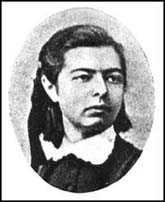Olga Lyubatovich
| Olga Lyubatovich | |
|---|---|
 | |
| Born |
1854 Russia |
| Died |
1917 Tbilisi, Russia |
Olga Spiridonovna Lyubatovich (Russian: Ольга Спиридоновна Любатович; 1854–1917) was a Russian revolutionary and member of Narodnaya Volya.
Biography
Early life
Lyubatovich was the daughter of political a refugee from Montenegro, born 1854. She wanted to study medicine in order to become a doctor, which was impossible for a woman to do in Russia. For this reason she went to study in Zürich with her sister Vera in 1871.[1]
Revolutionary life
Lyubatovich met Vera Figner in Zürich where she was recruited into the Revolutionary Socialist movement. She joined Pan-Russian social revolutionary group and in 1875 returned to Russia where she attempted to spread socialist propaganda among industry workers.
She was then arrested in Tula and kept in prison for two years before appearing in court. She was found guilty of distributing illegal publications. She was sentenced to nine years hard labour. But this was reduced to banishment to Siberia. In Tobolsk she was able to employ her medical knowledge to help the local people, where she became known as the "miracle worker".
In 1876 Lyubatovich escaped from Siberia and went into hiding in St. Petersburg. There she joined a unit of Land and Liberty group led by Sergey Stepnyak-Kravchinsky and Nikolai Morozov.
Lyubatovich also spent six months in Geneva where she lived with a group of émigré who had escaped from Russian authorities. This included Vera Zasulich, whose attempt to murder General Trepov, the Police chief of St. Petersburg, had made her a national figure in the revolutionary movement.
In October 1879, with Land and Liberty split into two, Lyubatovich joined the more radical Narodnaya Volya which adopted terrorist tactics.
At a meeting of the Executive Committee of Narodnaya Volya on August 26, 1879, it was decided that the organization should attempt to assassinate Emperor Alexander II. This led to Lyubatovich taking part in three unsuccessful attempts on the Tsar's life.
In 1880, there was internal dispute within the movement, on the purpose of terrorism. One side believing that terrorism's objective should be to force the government into granting democratic rights to the people, while others led by Lev Tikhomirov who was influenced by Sergei Nechayev argued that it was possible for terrorism to be used for a small group or revolutionaries to snatch power and then hand it over to the people.
Lyubatovich and Morozov strongly disagreed with the ideas of Tikhomirov. They argued that this was an example of Jacobinism and would thus result in the kind of dictatorship that had taken place after the French Revolution.
In 1880, she and Morozov left Narodnaya Volya and went to live in Geneva. While in exile Morozov wrote The Terrorist Struggle, a pamphlet that explained his views and how to achieve a democratic society in Russia. Based on ideas he and Lyubatovich had developed, moreover this literature advocated large numbers of small independent terrorist groups, he argued that this approach would make it difficult for the police to apprehend the terrorists. It would also help to prevent a small group of leaders gaining power, forming dictatorships after the overthrow of the Tsar.
Morozov returned to Russia in order to distribute The Terrorist Struggle. This led to his arrest soon after arriving. He was then imprisoned in Sulvalki. Lyubatovich only just having gone through child birth decided to attempt to rescue Morozov, though her plan did not go well, ending in her arrest leading to Liubatovich being sent to Siberia in November 1882.
She was released following the 1905 Revolution, as part of a political amnesty. After her return to St. Petersburg she wrote her memoirs.
Death and legacy
Olga Lyubatovich died in 1917.
Footnotes
- ↑ Zakharina, V. F. (1979). "Liubatovich, Vera Spiridonovna and Ol’ga Spiridonovna". The Great Soviet Encyclopedia (3rd ed.).
Further reading
- Stepniak (Sergey Stepnyak-Kravchinsky), A Female Nihilist. Boston: Benjamin R. Tucker, 1886.